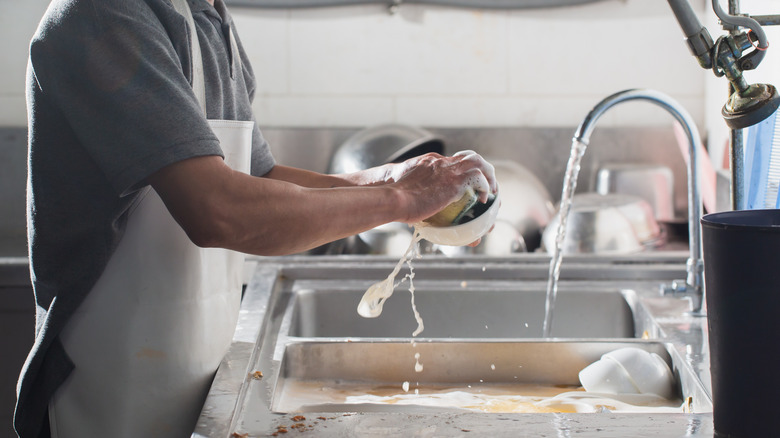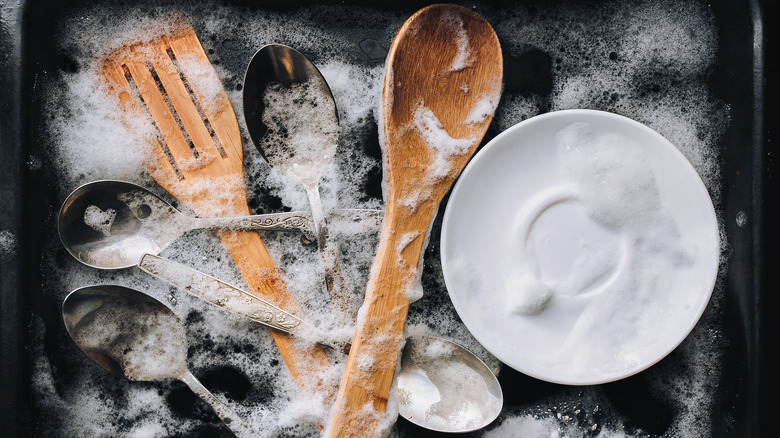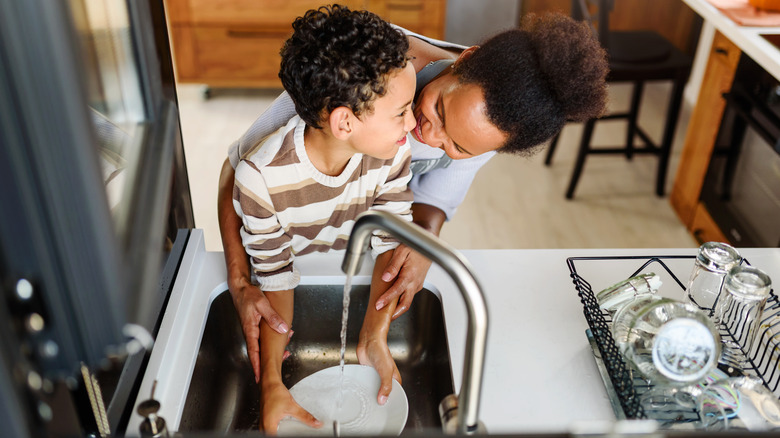Mistakes Everyone Makes When Doing The Dishes
If you hate washing the dishes, the dishwasher is probably your best friend. However, sometimes washing dishes by hand is necessary. Some pots, pans, or serving platters may be too big to fit in the dishwasher. Other dishes, like fine china, thin plastic, certain knives, and wood, are not dishwasher safe, per Whirlpool. Some don't use the dishwasher because washing by hand may be more effective or save energy. Also, some may not have access to a dishwasher.
Whatever the reason, we all sometimes have to wash dishes by hand. While you may think your current method of washing dishes is good enough, it may not be the most efficient way to clean your dishes. You may be wasting water, time, and resources. Or, perhaps you wash your dishes correctly, but they still come out with water spots and streaks. Here are the most common dishwashing mistakes and how to avoid making them yourself.
The most common dishwashing mistake
The most common dishwashing mistake has to do with the method used to wash dishes. Most people wash each dish individually under the faucet. They scrub with a sponge or rag and lots of soap. Then, after the dish has been cleaned, they rinse off the suds and place it on a towel or drying rack.
However, this method wastes water, time, and soap. Instead, the best way to clean your dishes is by soaking them. The American Cleaning Institute describes this method. You'll start by scraping off any excess food with a rubber spatula or paper towel. This food can be discarded in the trash can or the garbage disposal. Then, you'll want to fill your sink with hot water and a small amount of soap. Submerge your dishes in the water and let them soak. Then scrub each dish while still submerged in the water. If you have a two basin sink, you could fill the other basin with cold water. Once you've scrubbed the dishes, dunking them into the cold water will help remove the suds before placing them on the drying rack, per Consumer Reports.
Other mistakes
You may be making other dishwashing mistakes as well, starting with the amount of soap you use. Most dish soaps are extra concentrated and sudsy, meaning you don't need to use a lot. Just adding a little bit of soap to your hot water will thoroughly clean your dishes. Choosing to clean with a rag over a sponge may also be a mistake, per Bio Home Cares. This is because sponges will hold soap for much longer than rags. Or, perhaps you use a sponge, but you haven't cleaned or replaced it in a while. To disinfect your sponge, wring out any extra water and place it in the microwave for two minutes (as long as it doesn't contain metal). Sponges should also be replaced every two weeks.
Some also make the mistake of letting their silverware air dry. Martha Stewart says that because flatware is prone to water spots and streaks, drying with a towel is the best method. Finally, Stewart also says that cleaning off dairy products or starches with hot water is a mistake since hot water will cause these foods to become gummy. Instead, wash them in cold water.


